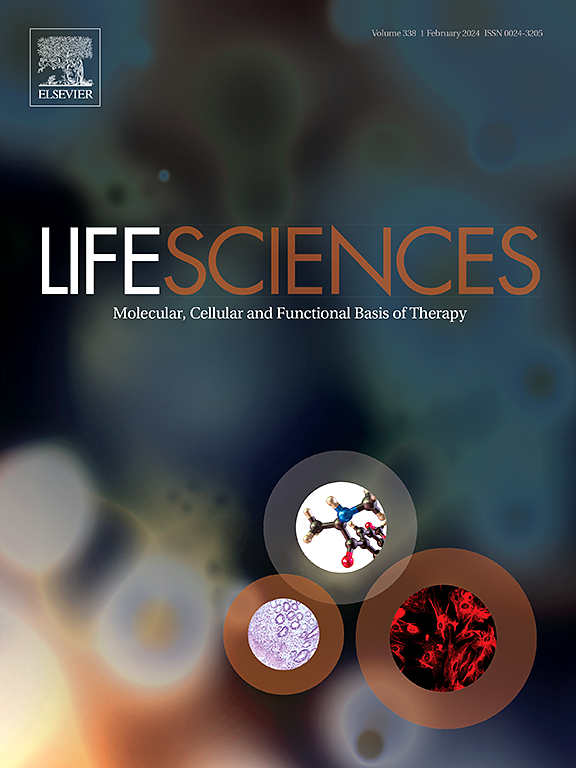亚硒酸钠通过 ROS 介导的葡萄糖代谢重编程抑制宫颈癌的进展。
IF 5.2
2区 医学
Q1 MEDICINE, RESEARCH & EXPERIMENTAL
引用次数: 0
摘要
目的:本研究旨在探讨硒通过抑制葡萄糖代谢重编程对宫颈癌的抑制作用及其内在机制:方法:亚硒酸钠(SS)处理过的 HeLa 和 SiHa 细胞用 CCK-8 检测法和免疫荧光法进行增殖评估。DNA 合成用 EdU 试验进行测定。裸鼠异种移植模型评估了 SS 的抗宫颈癌效果。使用流式细胞仪、DCFH-DA 和 JC-1 探针分别测量了活性氧(ROS)和线粒体膜电位。通过 Annexin V/PI 染色和 Western 印迹检测细胞凋亡。使用 2-NBDG 探针和检测试剂盒测定葡萄糖摄取、乳酸生成和 ATP 生成。使用 RT-qPCR 和 Western 印迹法测定了糖酵解相关基因 HK2、GLUT1 和 PDK1 的 mRNA 和蛋白质水平:主要发现:SS对HeLa和SiHa细胞活力的抑制呈剂量和时间依赖性。裸鼠腹腔注射 SS 能显著抑制 HeLa 细胞异种移植的生长,且无明显的肝毒性或肾毒性。SS 主要通过抑制 ROS 介导的 AKT/mTOR/HIF-1α 通路抑制癌细胞的葡萄糖代谢重编程。用 N-乙酰半胱氨酸(NAC)或 MHY1485(一种 mTOR 激活剂)进行预处理可部分逆转 SS 对葡萄糖代谢重编程、细胞增殖和迁移的抑制作用及其促凋亡作用:SS具有抗宫颈癌的作用,可能是通过诱导ROS生成和抑制宫颈癌细胞的葡萄糖代谢重编程,从而抑制细胞增殖和促进细胞凋亡。这些发现为了解 SS 的分子机制提供了新的视角,有助于开发治疗宫颈癌的新药。本文章由计算机程序翻译,如有差异,请以英文原文为准。
Sodium selenite inhibits cervical cancer progression via ROS-mediated suppression of glucose metabolic reprogramming
Aims
This study aims to explore the inhibitory effect of selenium on cervical cancer through suppression of glucose metabolic reprogramming and its underlying mechanisms.
Methods
Sodium selenite (SS) treated HeLa and SiHa cells were assessed for proliferation using the CCK-8 assay and immunofluorescence. DNA synthesis was measured with the EdU assay. A nude mouse xenograft model evaluated SS's anti-cervical cancer effects. Reactive oxygen species (ROS) and mitochondrial membrane potential were measured using flow cytometry, DCFH-DA, and JC-1 probes, respectively. Apoptosis was detected via Annexin V/PI staining and Western blot. Glucose uptake, lactate production, and ATP generation were determined using 2-NBDG probes and assay kits. The mRNA and protein levels of glycolysis-related genes HK2, GLUT1, and PDK1 were measured using RT-qPCR and Western blot.
Key findings
SS inhibited HeLa and SiHa cells viability in a dose- and time-dependent manner. Intraperitoneal injection of SS in nude mice significantly inhibited HeLa cell xenograft growth without evident hepatotoxicity or nephrotoxicity. SS inhibited glucose metabolic reprogramming in cancer cells primarily via ROS-mediated AKT/mTOR/HIF-1α pathway inhibition. Pretreatment with N-acetylcysteine (NAC) or MHY1485 (an mTOR activator) partially reversed the inhibitory effects of SS on glucose metabolic reprogramming, cell proliferation, and migration, as well as its pro-apoptotic effects.
Significance
SS exhibited anti-cervical cancer effects, likely through the induction of ROS generation and inhibition of glucose metabolic reprogramming in cervical cancer cells, thereby inhibiting cell proliferation and promoting apoptosis. These findings provide new insights into understanding the molecular mechanisms underlying SS for potential new drug development for cervical cancer.
求助全文
通过发布文献求助,成功后即可免费获取论文全文。
去求助
来源期刊

Life sciences
医学-药学
CiteScore
12.20
自引率
1.60%
发文量
841
审稿时长
6 months
期刊介绍:
Life Sciences is an international journal publishing articles that emphasize the molecular, cellular, and functional basis of therapy. The journal emphasizes the understanding of mechanism that is relevant to all aspects of human disease and translation to patients. All articles are rigorously reviewed.
The Journal favors publication of full-length papers where modern scientific technologies are used to explain molecular, cellular and physiological mechanisms. Articles that merely report observations are rarely accepted. Recommendations from the Declaration of Helsinki or NIH guidelines for care and use of laboratory animals must be adhered to. Articles should be written at a level accessible to readers who are non-specialists in the topic of the article themselves, but who are interested in the research. The Journal welcomes reviews on topics of wide interest to investigators in the life sciences. We particularly encourage submission of brief, focused reviews containing high-quality artwork and require the use of mechanistic summary diagrams.
 求助内容:
求助内容: 应助结果提醒方式:
应助结果提醒方式:


